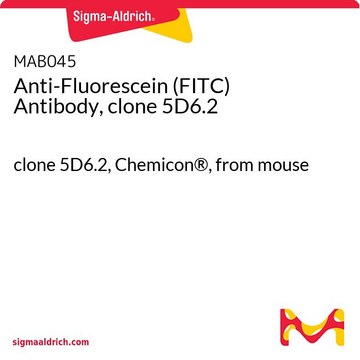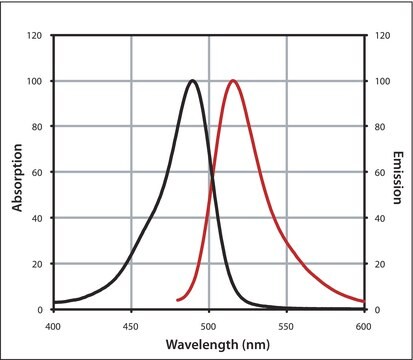SAB4200738
Anti-FITC antibody, Mouse monoclonal
clone FL-D6, purified from hybridoma cell culture
Sinônimo(s):
Anti-Fluorescein isothiocyanate
About This Item
Produtos recomendados
fonte biológica
mouse
Nível de qualidade
forma do anticorpo
purified from hybridoma cell culture
tipo de produto de anticorpo
primary antibodies
clone
FL-D6, monoclonal
forma
buffered aqueous solution
concentração
~1.0 mg/mL
técnica(s)
immunoblotting: 1.25-2.5 μg/mL using ExtrAvidin-FITC
immunohistochemistry: suitable
indirect ELISA: 0.15-0.3 μg/mL using 5 μg/ml ExtrAvidin-FITC
Isotipo
IgG1
Condições de expedição
dry ice
temperatura de armazenamento
−20°C
modificação pós-traducional do alvo
unmodified
Descrição geral
FITC (fluorescein isothiocyanate) is a fluorochrome dye that absorbs ultraviolet or blue light (with peak wavelength of approximately 495 nm) causing molecules to become excited and emit a visible yellow-green light (with peak wavelength of approximately 519 nm).
Especificidade
Imunogênio
Aplicação
- immunoblotting
- enzyme-linked immunosorbent assay (ELISA)
- immunohistochemistry
Ações bioquímicas/fisiológicas
forma física
Armazenamento e estabilidade
Exoneração de responsabilidade
Não está encontrando o produto certo?
Experimente o nosso Ferramenta de seleção de produtos.
Código de classe de armazenamento
10 - Combustible liquids
Ponto de fulgor (°F)
Not applicable
Ponto de fulgor (°C)
Not applicable
Certificados de análise (COA)
Busque Certificados de análise (COA) digitando o Número do Lote do produto. Os números de lote e remessa podem ser encontrados no rótulo de um produto após a palavra “Lot” ou “Batch”.
Já possui este produto?
Encontre a documentação dos produtos que você adquiriu recentemente na biblioteca de documentos.
Nossa equipe de cientistas tem experiência em todas as áreas de pesquisa, incluindo Life Sciences, ciência de materiais, síntese química, cromatografia, química analítica e muitas outras.
Entre em contato com a assistência técnica








